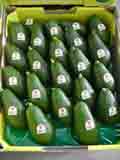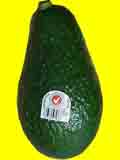|
Mareeba Shepard Avocados (Australian)

|
Shepard Avocados |
Contrary to popular belief, Shepard avocados do not contain any
cholesterol. In fact, all fruit is free from cholesterol.
Shepard avocados are perfect for salads and dips because the flesh won't go
brown once cut (no need for the lemon and clingwrap trick!)
Spread avocado
liberally on your breakfast toast, add them to your sandwich at lunchtime or mix
them into your salad or pasta for dinner.
Shepard avocado grower, Mrs Verna De Lai, says there is more to this
delicious fruit than we realise.
"Avocados are good for the body - both inside
and out. Each one of these flavoursome fruits contains folate, vitamins A, B6
and C, potassium (more than bananas!) and protein."
Levels of vitamins E, B1, B2 and B3 mean that avocados are great for healing,
repairing and restoring the skin.
"These nutritional qualities and smooth consistency make avocados one of the
first fresh fruits a baby can enjoy.
Shepard avocados are described as a whole
food, which means that each piece of fruit contains the vitamins and minerals
that are essential for infant development.
Due to their high energy content,
avocados are ideal for healthy, growing bodies."
Pureeing an avocado is not just good for baby; the ease of preparation makes
avocados good for new mothers too!
"It is true that avocados have a higher level
of fats than most other fruits, however it is important to realise what type of
fat this is," says Verna De Lai.
"Avocados are high in monounsaturated fat (the good fat) and contain more
than canola or olive oil.
Monounsaturated fats are an essential part of anyone's
diet, as they have been found to assist in actually lowering cholesterol
levels."
"Putting it into perspective, butter contains around 80% of saturated fat,
whilst avocados have been found to contain almost 25% of monounsaturated fat.
Avocados really are nature's own butter!"
Shepard avocados are grown in on the Atherton Tableland and in Bundaberg,
Queensland - the only places Shepards are grown in the world!
Alternative uses for Shepard Avocados
-
Spread Shepard avocado generously on your favourite wholegrain or sour
dough bread.
-
Wrap sliced Shepard avocado in rice and nori rolls and serve with your
favourite sushi.
-
Make your own facial moisturiser or massage lotion with blended Shepard
avocado.
-
Include Shepards in a homemade ice-cream recipe.
-
Puree Shepards with coffee and run to make an exotic cocktail.
-
Present colourfully wrapped Shepard avocados as gifts to friends.
-
Slice and decorate your favourite meal with a Shepard avocado fan.
Facts about Avocados
-
Avocados are believed to have been first eaten in Mexico around the 10th
Century.
-
Avocados have been found in Aztecs tombs, dating back to 750 BC.
-
European sailors used avocados to add some colour to their provisions,
naming the fruit "Midshipman's Butter".
-
Avocados were known in early America as "Alligator Pears".
-
The word "avocado" is thought to have originated from the Spanish word
"Aguacate".
Selection and Storage of Shepard Avocados
-
Shepard avocados are a green-skinned variety, which do not change colour
once ripe.
-
To select a ripe avocado, gently squeeze the fruit in the palm of your
hand.
-
A ripe Shepard will yield slightly to your touch. Store ripe Shepards
in the fridge - better still, eat them straight away!
-
Fruit for later use should be firm to touch and stored at room temperature
until ripe and ready to eat.
-
Cut Shepard avocados won't go brown in the fridge. To store half an
avocado, simply replace the seed in the fruit,
-
cover with clingwrap and
store in the fridge. Cut avocados should be eaten within a couple of days
How to Store
Storage Solutions
Whole, ripe Avocados can be stored in the refrigerator uncut for two to
three days.
Cut Avocado should be sprinkled with lemon juice, lime juice or white
vinegar and placed in an air-tight container in your refrigerator.
They should be eaten within a day or two.
If refrigerated guacamole turns brown during storage, simply discard the
top, browned layer.
Ripen
The right way to ripen
|
Did you know that no Avocados
ripen on trees? It's actually the harvesting (picking)
action that triggers the ripening process!
To take some of the 'guess work' out of ripening for
consumers, many wholesalers ensure that Australian Avocados
are delivered to retail stores about a day or two before
they are ripe.
To ripen an Avocado, place the fruit in a plain brown paper
bag and store at room temperature until ready to eat. This
will usually take two to five days. Including an apple or
banana in the bag accelerates the process, as these fruits
give off ethylene gas - a ripening agent.
Ripe fruit can be refrigerated until eaten, however, not for
more than two or three days.
There is no quicker way to ripen Avocados. A natural fruit
requires a natural process.
For further details on ripening avocados, download the
Australian Avocados Ripeness Chart below.
 Stage of ripeness poster
Stage of ripeness poster |
 |
How to Peel
Easy peeling
This simple three-step process will help you get the
most out of your
Australian Avocados:
|
1. Start
with a ripe Avocado and cut it lengthwise around the
seed. Rotate the halves to separate. |
 |
|
2. Remove
the seed by sliding the tip of a spoon gently underneath
and lifting out.
(The other common seed-extraction method of striking
the seed with a knife can be dangerous and is not
recommended.) |
 |
|
3. Peel
the fruit by placing the cut side down and removing the
skin with a knife or your fingers, starting at
the small end. An alternative is to simply scoop out the
Avocado flesh with a spoon.
Be sure to sprinkle all cut surfaces with lemon
juice, lime juice or white vinegar, to prevent
discolouration. |
 |
• SEASONAL
AVAILABILITY - January to April
• GENERAL INFORMATION:
A round to pear shaped
fruit with a mid to
dark green skin.
Inside, the flesh is soft and creamy surrounding a large
seed.
• NUTRITION FACTS:
A highly nutritious
fruit being a good source of
vitamin C, vitamin E
and niacin (B3). Avocados are also a minor source
of vitamin A, thiamin
(B1), folate and iron. Avocados, like all plant
products, do not
contain cholesterol.
• PREPARATION & USAGE
TIPS:
Best eaten raw as they
become bitter
with high heat. Cut in
half and remove the stone. Remove skin, slice
flesh. Brush with
fresh lemon juice to stop flesh discolouration.
• STORAGE AND HANDLING
TIPS:
Ripen at room
temperature and
then store in
refrigerator.
• NUTRITION INFORMATION PANEL
| |
Quantity per serving
(serving size 121g) |
Quantity per 100g |
| Energy |
1073KJ |
887KJ |
| Protein |
2.30g |
1.9g |
| Fat, total |
27.3g |
22.6g |
| -saturated |
5.9g |
4.9g |
| -polyunsaturated |
3.4g |
2.8g |
| -monounsaturated |
17.7g |
14.7g |
| Carbohydrate |
0.48g |
0.40g |
| -sugars |
0.48g |
0.40g |
| Dietary fibre, total |
1.82g |
1.5g |
| Sodium |
2.4mg |
2mg |
| Vitamin A |
59mcg (8% RDI*) |
49mcg (7% RDI*) |
| Vitamin E |
1.73mg (17% RDI*) |
1.43mg (14% RDI*) |
| Thiamin (B1) |
0.08mg (7% RDI*) |
0.07mg (6% RDI*) |
| Niacin (B3) |
2.06mg (19% RDI*) |
1.7mg (15% RDI*) |
| Folate |
13.3mcg (7% RDI*) |
11mcg (6% RDI*) |
| Vitamin C |
10.9mg (36% RDI*) |
9mg (30% RDI*) |
| Iron |
0.85mg (8% RDI*) |
0.7mg (7% RDI*) |
| Potassium |
570mg |
471mg |
* Recommended Daily Intake
QUANTITIES STATED ABOVE ARE AVERAGES ONLY
Please Note: This
information may vary due to seasonal influences and varietal differences.
This fact sheet is not
a substitute for specific dietary advice.

Mangoes |
Lychees |
Dried Mangoes
more info at
http://www.avocado.org.au/

|







